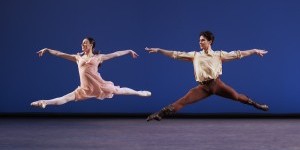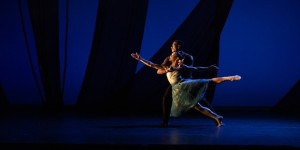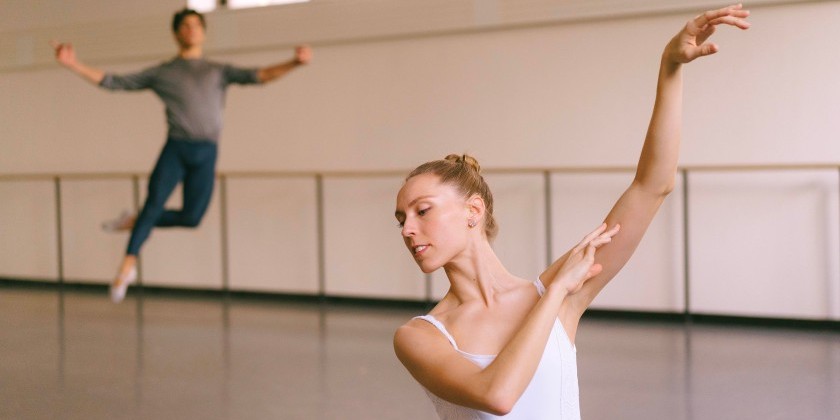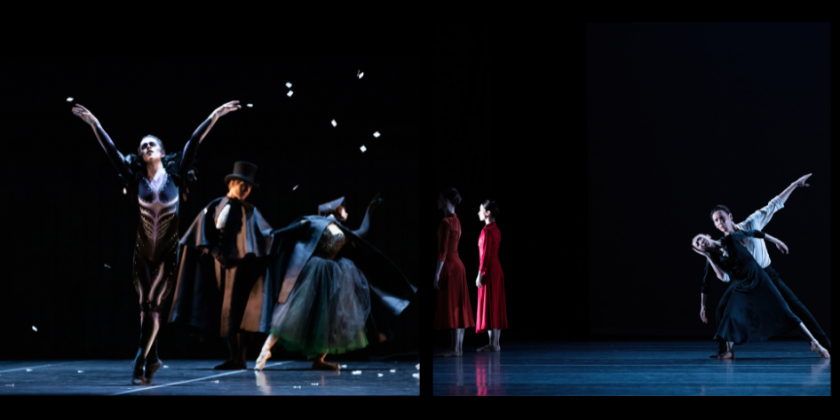IMPRESSIONS: New York City Ballet's 75th Spring Season “The Future” at Lincoln Center
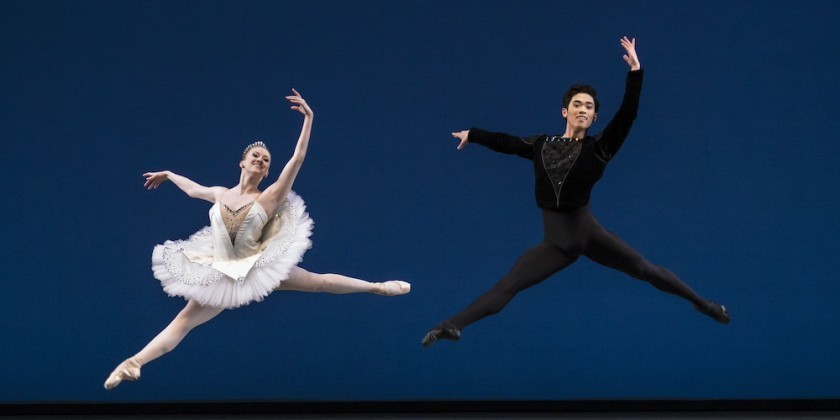
Bourrée Fantasque (Music: Emmanuel Chabrier)
The Steadfast Tin Soldier (Music: Georges Bizet)
Errante (Music: Maurice Ravel)
Symphony in C (Music: Georges Bizet)
Dates: Tuesday, April 23 and Wednesday, April 24, 2024
Conductor: Andrew Litton
The spring segment of New York City Ballet’s 75th-anniversary season at the David H. Koch Theater opens with a program dedicated to founding choreographer George Balanchine.
Last season’s new production of the 1949 Bourrée Fantasque, set to music by French composer Emmanuel Chabrier, includes the overture of his well-known “Marche Joyeuse,” his late work “Bourrée Fantasque,” and two segments of his seldom-played operas.
When Balanchine spoofed ballet conventions in this supposedly comic ballet, his ideas may have seemed original, but they do not come across as fresh today. After three quarters of a century of comic takes on ballet conventions, Bourrée Fantasque reads as pleasant bourgeois entertainment at best.
The costuming of the corps de ballet, made up of ladies in tutus with fan in hand and men wearing berets, signals retro lightness. The nostalgic, cream-puff cheer wears thin quickly. Casting tall Emily Kikta with short KJ Takahashi in the first section on opening night has me worried for a moment that she might not see him, and could accidentally step on him and squash him. However, he lifts and holds her heroically without breaking his back.

Emilie Gerrity and Gilbert Bolden III in George Balanchine’s Bourrée Fantasque. Photo: Erin Baiano
The men lie down on their bellies and rest their chins on their hands atop their propped-up forearms. Does this angle give them a glimpse of the ladies’ crotches? Does anyone care?
On Wednesday evening, Mira Nadon and Andres Zuniga are not as obviously mismatched, and I can appreciate Balanchine’s occasional references to commedia dell’arte.
In the work’s second section, “Prélude,” Emilie Gerrity and Gilbert Bolden III, who are both scheduled to dance on Wednesday, have to step in on Tuesday evening as well. Had they ever seen one another before? I have never seen any couple improve from one day to the next as much as they do. The greyish blue romantic tutus of the women sans fans would give this movement an almost elegiac feel, were it not for the men who still sport berets.
In the last movement, “Fête Polonaise,” Victor Abreu battles with Alexa Maxwell through Tuesday’s performance. They both lose. Their individual timing does not have anything to do with the music; and, to their detriment, they are out of synch with one another. He fails to lift her when she jumps backwards into him, but at least he manages to catch her before she falls. On Wednesday, Abreu avoids his previous mishaps partnering Emma von Enck, but the result still looks far from joyful and carefree.
Karinska’s colorful outfits brighten the stage in the 42-member cast finale. I applaud the care given to the recreation of the garments by New York City Ballet’s costume shop.

Erica Pereira and Anthony Huxley in George Balanchine’s The Steadfast Tin Soldier. Photo: Erin Baiano
A stage set with a Christmas tree and a fireplace flanked by a small regiment of cutout life-sized toy soldiers as well as gifts, balloons, and a doll in a well-appointed home make me question if The Steadfast Tin Soldier (1975) is fitting for the opening night of a spring season. Based on Hans Christian Andersen’s story of a toy soldier’s burning love for a paper doll, the pas de deux is one of the most sentimental in the company’s repertoire. Erica Pereira and Anthony Huxley on opening night, as well as Megan Fairchild and Daniel Ulbricht on Wednesday evening, engage one in their love story that comes to a tragic end when the wind blows the doll into the fireplace.
The much talked about renaming of another 1975 work, Tzigane, which has been dubbed Errante to avoid offending modern sensibilities, becomes a joke when I glance at another program given later the same week. That bill includes a “Rondo alla Zingarese.” Does it depend on the foreign language if a supposedly objectionable term can be used?

Mira Nadon, Aarón Sanz and the Company of New York City Ballet in George Balanchine’s Errante. Photo: Erin Baiano
Mira Nadon wears golden earrings that look like she borrowed them from Marlene Dietrich. Just as wonderful as Dietrich’s portrayal of a gypsy woman in the 1947 Paramount feature Golden Earrings, Nadon vamps sensuously through her movement material. Aaron Sanz, however, is relegated to a supporting role; and does not get to wear earrings, unlike Ray Milland in the movie, who - hard to believe - even got top billing over Dietrich. In the ballet, Balanchine celebrated the return of ballerina Suzanne Farrell, his fugitive muse. The work makes clear how much he must have loved watching her, and resented that Peter Martins, and not he, got to dance with her. Farrell, responsible for the staging – and (according to a source within the company) the name change – takes a bow on opening night. Notably, Nadon and Sanz dance all performances. There is no second cast. Kurt Nikkanen is the solo violinist for Maurice Ravel’s 1924 composition “Tzigane.”
The festive Symphony in C brings the program to a close. Unfortunately, on opening night I find it difficult to concentrate on the artistry of the principal couples in the first two movements, because the partnering of the demi-soloists is abysmal. Young dancers need to learn new roles, but I wish there were enough rehearsal time to prepare them properly. It is not fair to them, the audience, or principal dancers Megan Fairchild, Joseph Gordon, Sara Mearns, and Tyler Angle.
The third movement steals the show for two reasons. One: Emma von Enck and Roman Mejia pull out all the stops. It’s playtime in the garden of virtuosity. Two: Demi-Soloists Mary Elizabeth Sell, Charlie Klesa, Mary Thomas MacKinnon, and Samuel Melnikov partner with self-effacing elegance and jolly assurance.
Alston Macgill makes one forget that she has to step in for another dancer on short notice, leading the fourth movement with Harrison Coll before the work culminates in its rousing ensemble.

Megan Fairchild, Joseph Gordon and the Company of New York City Ballet in George Balanchine’s Symphony in C. Photo: Erin Baiano
On Wednesday night, the same demi-soloists in the first two movements either have had time to learn their parts, or I have managed to concentrate my gaze on the principal couples. Emilie Gerrity also steps in for an injured dancer, making her debut in the first movement alongside Chun Wai Chan. Hats off to her. In the second movement, “Adagio,” Unity Phelan looks secure and serene in and out of the hands of Alec Knight. She knows how to build and ride a phrase taking an enchanted audience with her. Baily Jones and KJ Takahashi are sprightly enough in the third movement; and Macgill replaces yet another dancer on short notice next to Troy Schumacher in the fourth and final section.
With premieres to come and many masterworks scheduled, the dancers have their plates full. Injuries signal that they might be too full, or that the workload needs to be rearranged. I hope all the dancers will be given the care, time, and attention they need to thrive and prosper. The company describes its spring season on the cover of the playbill as “The Future.” I keep my fingers crossed, and wish for the best.





